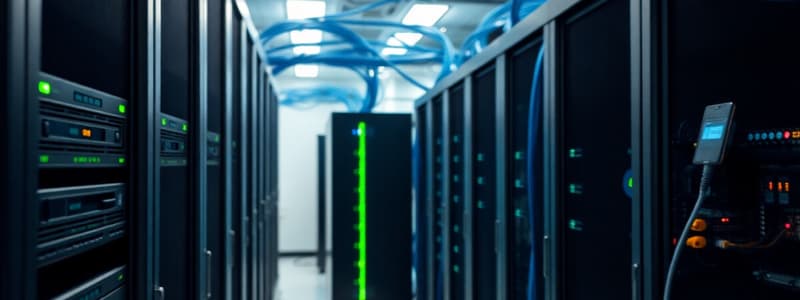Podcast
Questions and Answers
What are the four main number systems discussed in Unit 1?
What are the four main number systems discussed in Unit 1?
- Binary, Hexadecimal, Octal, Decimal
- Decimal, Octal, Hexadecimal, Binary
- Binary, Octal, Decimal, Hexadecimal (correct)
- Binary, Decimal, Hexadecimal, Octal
What are the two main hardware components of a computer system?
What are the two main hardware components of a computer system?
Hardware and Software
Which two types of operating systems are mentioned in Unit 2?
Which two types of operating systems are mentioned in Unit 2?
- Windows and Linux (correct)
- iOS and Android
- Windows and MacOS
- MacOS and ChromeOS
What are the three types of computer networks discussed in Unit 3?
What are the three types of computer networks discussed in Unit 3?
What does IMEI stand for?
What does IMEI stand for?
According to Unit 5, which three types of crimes associated with social media are listed?
According to Unit 5, which three types of crimes associated with social media are listed?
What are the two main categories of cybercrime discussed in Unit 6?
What are the two main categories of cybercrime discussed in Unit 6?
Which of the following is NOT a listed reference for Cyber Commando Training 2025?
Which of the following is NOT a listed reference for Cyber Commando Training 2025?
Flashcards
Binary Number System
Binary Number System
A number system using only two digits, 0 and 1. Each digit represents a power of 2.
Decimal Number System
Decimal Number System
A number system using base 10, with digits from 0 to 9.
Binary to Decimal Conversion
Binary to Decimal Conversion
A conversion process from binary to decimal, where each binary digit is multiplied by a power of 2, and the results are added together.
Decimal to Binary Conversion
Decimal to Binary Conversion
Signup and view all the flashcards
Hexadecimal Number System
Hexadecimal Number System
Signup and view all the flashcards
Signed Binary Numbers
Signed Binary Numbers
Signup and view all the flashcards
ASCII (American Standard Code for Information Interchange)
ASCII (American Standard Code for Information Interchange)
Signup and view all the flashcards
UTF (Unicode Transformation Format)
UTF (Unicode Transformation Format)
Signup and view all the flashcards
Processor (CPU)
Processor (CPU)
Signup and view all the flashcards
Motherboard
Motherboard
Signup and view all the flashcards
RAM (Random Access Memory)
RAM (Random Access Memory)
Signup and view all the flashcards
Storage Devices
Storage Devices
Signup and view all the flashcards
Operating System (OS)
Operating System (OS)
Signup and view all the flashcards
Booting Process
Booting Process
Signup and view all the flashcards
LAN (Local Area Network)
LAN (Local Area Network)
Signup and view all the flashcards
MAN (Metropolitan Area Network)
MAN (Metropolitan Area Network)
Signup and view all the flashcards
WAN (Wide Area Network)
WAN (Wide Area Network)
Signup and view all the flashcards
Router
Router
Signup and view all the flashcards
TCP/IP Protocol Suite
TCP/IP Protocol Suite
Signup and view all the flashcards
MAC Address
MAC Address
Signup and view all the flashcards
Protocols
Protocols
Signup and view all the flashcards
Firewall
Firewall
Signup and view all the flashcards
IDS (Intrusion Detection System)
IDS (Intrusion Detection System)
Signup and view all the flashcards
IPS (Intrusion Prevention System)
IPS (Intrusion Prevention System)
Signup and view all the flashcards
Cybercrime
Cybercrime
Signup and view all the flashcards
Cyberbullying
Cyberbullying
Signup and view all the flashcards
Online Grooming
Online Grooming
Signup and view all the flashcards
Cyberstalking
Cyberstalking
Signup and view all the flashcards
IMEI (International Mobile Equipment Identity)
IMEI (International Mobile Equipment Identity)
Signup and view all the flashcards
SIM (Subscriber Identity Module)
SIM (Subscriber Identity Module)
Signup and view all the flashcards
Study Notes
Cyber Commando Training Program Screening Test Syllabus
-
Unit 1: Introduction to number systems (binary, octal, decimal, hexadecimal), conversions between systems, ASCII, and UTF representation. Definition and history of computers, computer architecture, hardware, software, programming languages, compilers, and interpreters.
-
Unit 2: Computer hardware components (motherboard, processors, memory, storage devices, networking components). Primary and secondary storage devices. Computer operating systems (OS), booting process, types of OS (Windows, Linux). Introduction to file systems.
-
Unit 3: Computer networks (LAN, MAN, WAN), network components, topology, digital and analog signaling. Routing protocols, IP addresses, classes, subnet masks, MAC addresses (media access control addresses), firewall, intrusion detection systems (IDS), intrusion prevention systems (IPS), network and internet-related crimes.
-
Unit 4: Mobile technologies (CDMA, GSM), mobile device hardware and software, mobile operating systems, IMEI (International Mobile Equipment Identity), SIM (Subscriber Identity Module) cards, smartphones.
-
Unit 5: Social media, security issues in social media, cyberbullying, online grooming, cyberstalking, social media's impact on business, politics, and revolutions, emerging trends in social media.
-
Unit 6: General knowledge, general intelligence, reasoning, general awareness, quantitative aptitude, English language, comprehension, statistics.
References and Suggested Readings
- Operating Systems Internals and Design Principles (9th edition) by William Stallings
- Computer Architecture and Organization by John P. Hayes
- Fundamentals of Computers (6th edition) by V. Rajaraman and Niharika Adabala.
- Computer Fundamentals by Anita Goel
- Data Communication and Networking (4th edition) by Behrouz A. Forouzan
- Modern Operating Systems (2nd edition) by Andrew S. Tanenbaum
- Operating Systems: A Modern Perspective (2nd edition) by Gary Nutt
- Operating Systems Internals and Design Principles (5th edition) by William Stallings
- Practical Guide to Computer Forensics Investigations by William Oettinger, a beginner's guide to searching, analyzing, and securing digital evidence
- Cyber Security: Understanding Cyber Crimes, Computer Forensics and Legal Perspectives by Nina Godbole and Sunit Belapore.
Studying That Suits You
Use AI to generate personalized quizzes and flashcards to suit your learning preferences.




